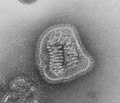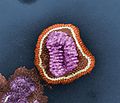Vaizdas:Influenza virus particle 8430 lores.jpg

Šios peržiūros dydis: 701 × 600 taškų. Kitos 5 rezoliucijos: 281 × 240 taškų | 561 × 480 taškų | 898 × 768 taškų | 1 197 × 1 024 taškų | 1 663 × 1 423 taškų.
Didesnės raiškos iliustracija (1 663 × 1 423 taškų, rinkmenos dydis: 763 KiB, MIME tipas: image/jpeg)
Rinkmenos istorija
Paspauskite ant datos/laiko, kad pamatytumėte rinkmeną tokią, kokia ji buvo tuo metu.
| Data/Laikas | Miniatiūra | Matmenys | Naudotojas | Paaiškinimas | |
|---|---|---|---|---|---|
| dabartinis | 11:45, 19 lapkričio 2010 |  | 1 663 × 1 423 (763 KiB) | Masur | original resolution |
| 22:35, 2 gegužės 2006 |  | 700 × 598 (45 KiB) | Patho | {{Information| |Description=PHIL Image 8430 ID#: 8430 Description: This negative-stained transmission electron micrograph (TEM) depicts the ultrastructural details of an influenza virus particle, or “virion”. A member of the taxonomic family Orthomyx |
Paveikslėlio naudojimas
Paveikslėlis yra naudojamas šiuose puslapiuose:
Visuotinis rinkmenos naudojimas
Ši rinkmena naudojama šiose viki svetainėse:
- Naudojama be.wikipedia.org
- Naudojama cs.wikipedia.org
- Naudojama de.wikipedia.org
- Naudojama de.wikibooks.org
- Naudojama en.wikipedia.org
- Naudojama es.wikipedia.org
- Naudojama et.wikipedia.org
- Naudojama eu.wikipedia.org
- Naudojama fa.wikipedia.org
- Naudojama fr.wikipedia.org
- Naudojama he.wikipedia.org
- Naudojama hy.wikipedia.org
- Naudojama it.wikipedia.org
- Naudojama ja.wikipedia.org
- Naudojama ml.wikipedia.org
- Naudojama nl.wikipedia.org
- Naudojama ru.wikipedia.org
- Naudojama sr.wikipedia.org




